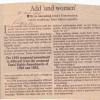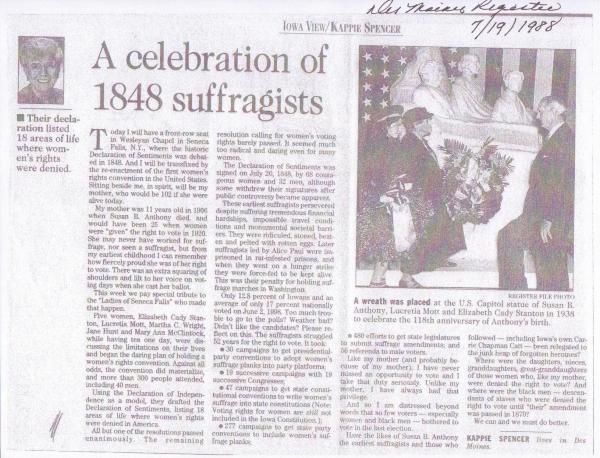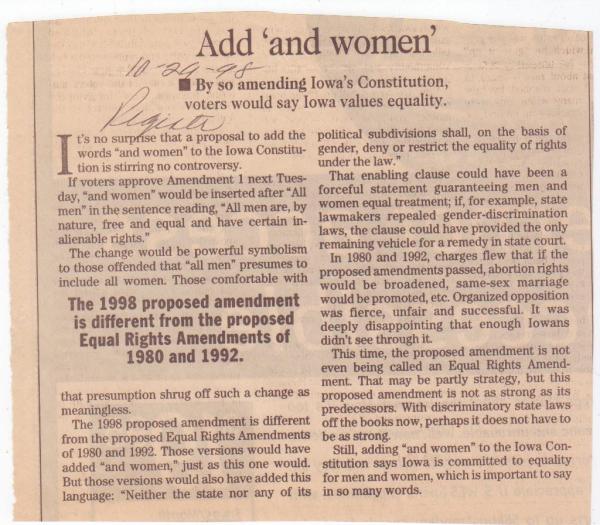Are Women Equal in Iowa?
| Grade | 9th -12th Grades | Class | Government or Contemporary Issues | Length of Lesson | 50 minutes |
| Lesson Title | Are Women Equal in Iowa? |
| Unit Title | Civil Rights and Inequalities |
| Unit Compelling Question | What groups or individuals currently have or have had their rights denied? |
| Historical Context: 2018.049.001 Lonabelle Kaplan "Kappie" Spencer is known as a political activist and women's rights advocate from Owatonna, Minnesota. After graduating from Grinnell College with a degree in physical education, Spencer and her husband moved to Des Moines. Spencer served in various positions with the Girl Scouts of America where she became involved in activism and lobbying after a hog lot was built next to a Girl Scout camp and Spencer supported regulations of air quality. 2018.049.002 |
|
| Lesson Supporting Question | |
| Lesson Overview | Students will be introduced to the Declaration of Sentiments, the Seneca Falls Convention, and the Equal Rights Amendment and how these events have influenced women in Iowa. They will collaborate in pairs or small groups to analyze primary sources, and they will work individually to formulate an argument about whether or not they think that women in Iowa are equal. The purpose of the lesson is to introduce students to the influence that civil rights movements have had in Iowa, and how Iowans have influenced civil rights movements in America while specifically looking at women’s rights. |
| Primary Sources Used |
|
| Resources Needed | https://iowamuseums.pastperfectonline.com/webobject/5995A0D8-D223-4EA4-8264-535055734925 https://iowamuseums.pastperfectonline.com/webobject/7A3B0703-2463-450D-9306-121533222424 https://www.youtube.com/watch?v=Tjnk3zBo-1I |
| Standard | |
| Lesson Target | Students will collaborate to analyze primary sources regarding the Seneca Falls Convention and the Equal Rights Amendment. (Bloom's Taxonomy Level 2 & 4);Students will develop an argument while citing evidence stating whether or not they believe women today are equal in Iowa by law. (DOK Level 3 & 4) |
| Lesson Themes | Civil Rights, Lawmaking, Women's Experience |
|
| Formative Assessment (How will you use the formative assessments to monitor and inform instruction?) |
The teacher will be completing informal formative assessments during the question-answer portions of the presentation as well as when the students are working in their partnerships and groups. During these times, the teacher will continuously be checking for student understanding in order to answer questions and provide clarification. The primary assessment in this lesson is the handout. This assessment is both formal and formative. The teacher will use the handout to assess for student comprehension of the two sources, and their ability to formulate an argument and cite evidence. |
| Summative Assessment (How does the lesson connect to planned summative assessment(s)?) |
There is not a summative assessment during this lesson. Components of this lesson, such as the Seneca Falls Convention, the Equal Rights Amendment, and Iowa’s influence on women’s rights, will be assessed in the summative assessment at the end of the Civil Rights and Inequalities unit. |
| Author | Alaine Brucher | Created | Last Edited | ||||
| Reviewer: Chad Christopher, History Education, University of Northern Iowa | |||||||
| Lesson Plan Development Notes: Teaching Methods, University of Northern Iowa, Fall 2019 | |||||||




